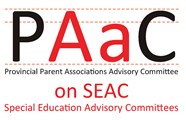Evaluation of SEAC, by its members, is helpful in supporting SEAC member engagement and sense of accomplishment. PAAC on SEAC recommends that each SEAC should periodically conduct a self-evaluation.
In order to evaluate the committee, all members must agree on the framework or criteria to be used to measure SEAC effectiveness. The evaluation could be framed around the roles and responsibilities of SEAC based on Regulation 464, and the annual goals that SEAC has established for itself. (See Section 3.1 and 3.2 for more information on goal setting.)
Effective Practices for evaluation of SEAC effectiveness include:
- Utilizing school board staff expertise, or research department, to help SEAC members design an evaluation process.
- Considering the PAAC on SEAC list of discussion questions in Table 3 as part of the evaluation process.
- Inviting an external facilitator or consultant to assist SEAC in designing and conducting an evaluation process.
- Developing a survey or key questions for SEAC members to answer.
- Allocating time within the regular SEAC Meetings for a facilitated discussion.
- Holding a special meeting of SEAC Members to focus on evaluation.
Table 3: SEAC Evaluation Discussion Questions
|
Topic |
Membership Questions |
| Membership | Does the current membership represent all of the exceptionalities? Does the current membership include parents of exceptional students? Is it necessary to recruit additional members? |
| Special Education Programs and Services | How do SEAC members get information to improve their understanding of the school board’s special education programs and services? How have SEAC members been consulted as part of the annual review of special education programs and services? |
| Special Education Plan | How was SEAC involved in the development or review of the Special Education Report? Is the Special Education Plan available in an easy to understand language and accessible to parents? |
| Special Education Budget | How did SEAC members get the information they needed to make informed decisions? Do all the members of SEAC have a good understanding of school board budgets and budget process? Do SEAC members need more help to understand and evaluate financial information? |
| Board Improvement Plans for Student Achievement | Do SEAC members have a good understanding of Board Improvement Plans for Student Achievement? How is SEAC involved in board improvement planning process? |
| Meetings | How does the Agenda support SEAC members’ information needs and decision making? Do SEAC members have adequate time at meetings for discussion on each topic? Are SEAC meetings well attended and do all members contribute? |
| Motions | How is the advice of SEAC documented? What is the process for Motions to the Trustees? Who reports back from the Trustees to SEAC? How does SEAC share information and recommendations with the Trustees? |
| Member Orientation, Training and Recognition | How are new SEAC members supported? How are training and orientation provided? How are members’ contributions recognized? Do SEAC members require additional training? Are there additional items that could be included in the SEAC Orientation manual? |
| Collaboration and Decision Making | How do SEAC members collaborate and work on common goals? What else can we do to build trust and enhance collaboration? How are differences resolved? |
| Public Consultation and Parent Engagement | How is information about SEAC, its members and meetings, made accessible and easy to understand by parents? Is there anything more that can be done to improve awareness of SEAC? |
